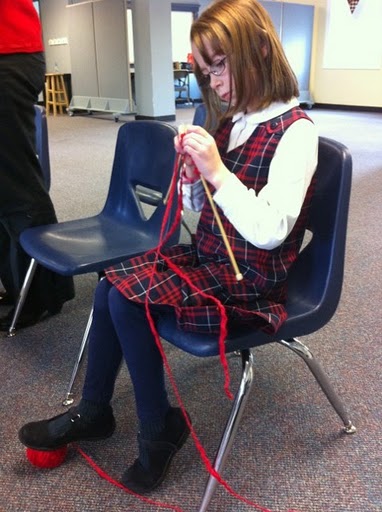by Kim Sceggel, Class Three Teacher
“The human hand is a wonderful and exquisite instrument to be used in a hundred movements exacting delicacy, direction and force; every such movement is a cause of joy as it leads to the pleasure of execution and the triumph of success.”
– Charlotte Mason
Consider the dozens of ways in which hands are used every day. Hands create paintings, sculptures, sonatas, edifices, cuisine, gardens, and other things of beauty.
Hands are also instruments of good, including helping another with a heavy package across an icy parking lot, writing words of encouragement, or preparing a homemade gift.
We value the “hands” of our students at Clapham School. And so, for the first time since Clapham’s inception, teachers are introducing their students to “handwork” in the classroom. Handwork projects vary by age and include everything from weaving to calligraphy to knitting.
While handwork is not one of the core subjects like literature, math, or writing, it holds a unique niche in the Clapham curriculum because, as Charlotte Mason reminds us, “’Education is the science of relations’; that is, a child has natural relations with a vast number of things and thoughts: so we train him upon physical exercises, nature lore, handicrafts, science and art.”[1]

Just as we desire our students to develop relationships with the authors of living books, so we encourage them to relate to different materials. Charlotte Mason explains, “[A student] practices various handcrafts that he may know the feel of wood, clay, leather, and the joy of handling tools, that is, that he may establish a due relation with materials. But, always, it is the book, the knowledge, the clay, the bird or blossom, he thinks of, not his own place or his own progress.”[2] In a classical sense then, handwork allows time for the contemplation of beauty. Students create something that reflects this eternal beauty.
Maryellen St. Cyr from Ambleside Schools offers several principles from Charlotte Mason which guide our handcraft instruction here at Clapham:
- We endeavor to select useful and beautiful projects, those that will not be thrown away after a few weeks of display on the refrigerator or the shelf.
- In order to facilitate the students’ clear understanding of the task, teachers present each project in a careful, deliberate sequence.
- We expect the students to do excellent work. This concept is “not in the sense of flawlessness, but that which was attempted with both heart and hand . . . .It is not enough that the child has participated; she must also learn.”[3] Teachers carefully instruct, not only praising honest effort but also calmly assisting when careless work must be redone.
- Finally, teachers consider the capabilities of the child as a person, designing projects that the students can accomplish at their various age levels.
Handwork projects at our school are even engaging students beyond the time allotted for handwork lessons. An observer at Clapham may see students knitting during read aloud time or cross stitching during indoor playtime. Several of my Class Three students have eagerly embraced our stitching projects and have used their new stitching skills to make gifts for family and friends.
Watching children use their hands to practice handwork reminds me that we are “fearfully and wonderfully made”(Psalm 139:14). God has given children wonderful abilities to do much more than they can even imagine. It is our hope that handwork will be a source of joy to the students as they develop relationships with the materials they encounter. Perhaps these projects will also be a source of joy to those who may receive them as gifts.
[1] Mason, Charlotte. Towards a Philosophy of Education. Seven Treasures Publications, 2009. 154. Emphasis mine.
[2] Ibid. 31.
[3] Cooper, Elaine. When Children Love to Learn. Crossway Books, 2004. 191.
